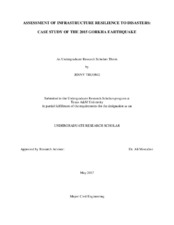| dc.description.abstract | Natural disasters, such as earthquake, flood, hurricane and tornado, cause disruptions and damages in different infrastructure systems (e.g., water, electricity, road), and thus, greatly affect the quality of life. Despite the existing studies on infrastructure disaster resilience, an integrated framework for resilience assessment of interconnected infrastructure systems, especially in developing countries, is still missing. To this end, we proposed an integrated framework for assessment of resilience in interconnected infrastructure systems. The proposed framework includes eight indicators of infrastructure resilience: vulnerability, anticipation, redundancy, adaptive capacity, rapidity, resourcefulness, cross-scale interactions, and learning culture. In addition, three different types of infrastructure interdependencies that could affect the resilience of interconnected infrastructure systems are identified in the proposed framework. The proposed framework was used to examine the resilience performance of three infrastructure sectors (i.e., water, electricity, and road) in a case study of 2015 Gorkha Earthquake in Nepal. Using qualitative data collected from 45 in-depth interviews conducted with subject matter experts who were involved in the response and recovery process of Gorkha earthquake, key factors contributing to different resilience indicators as well as interdependencies between infrastructure sectors were identified. The data analysis results show that in general, the infrastructure systems in Nepal have inherent vulnerability even before the earthquake. There was anticipation of the occurrence of the earthquake. However, not enough preparation effort was made. After the earthquake, preliminary assessment and response were conducted in different infrastructure sectors. However, there was a severe delay in long-term reconstruction planning. The redundancy in water and electricity sectors developed over time (e.g., water tanks and privately-owned generators) due to the supply-demand disparity has helped the infrastructure systems to cope with the effects of the earthquake. The research findings also reveal how the interdependencies between different infrastructure sectors affected the disaster response and recovery in Nepal. For example, in some parts of Nepal, roads were narrow and when buildings collapsed, many roads were inaccessible, which affected the recovery process in electricity and water sectors. The study has important implications for engineers and decision-makers as it identified the characteristics of infrastructure systems in Nepal that contribute to different resilience indicators. In addition, the systematic qualitative data analysis method and the resilience assessment framework proposed in this study provide new opportunities for disaster resilience studies in the future. | en |


